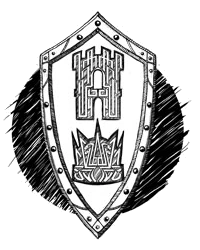
Stylized Glyphpair representing
Dalinar Kholin's Sigil
Glyphs are symmetrically inscribed symbols that form a written system of communication easily accessed by both the literate and illiterate.
Each glyph conveys a single idea.[1]
History
According to mythology, glyphs are said to have come from the Dawnsingers, who were sent by the Almighty to help mankind. Many glyph-inscribed relics (such as weapons, buildings, and mystical items) from the Heraldic Epochs have been and are still being discovered throughout Roshar. Such discoveries build a solid case that supports the theory that the glyph system is the oldest form of communication known on Roshar.
The aforementioned relics include the inside of the Palanaeum (said to be built by the Dawnsingers themselves), Honorblades wielded by the Heralds (similar to their lesser iterations known as Shardblades, the sides of which sometimes bear glyphs),[2] and Shardplate worn by the Knights Radiant (which glowed in hues that modern Plate can only imitate with paint). Stormlight flares from Surgebinders sometimes form glyphs.
In the modern era, glyphs are commonly used among the Vorin kingdoms. Information concerning the nature and use of glyphs throughout the rest of the world is sparse; the Parshendi wield weapons decorated with unfamiliar glyphs yet to be deciphered.
It has been theorized that the original symbolic associations of the glyphs may have been lost or altered over time, similar to what happened to the Dawnchant.
Overview
In Vorin kingdoms, where reading and writing are considered feminine arts, only the glyph system is considered proper for non-ardent men to learn. While most lighteyed children can read glyphs, many darkeyes (who form the majority of the population) are illiterate.[3] As such, glyphs are often styled into commonly understood concepts so that the illiterate will be able to recognize them (i.e., book-shaped glyphs decorating the fronts of bookstores).
Glyph writing consists of major, minor, and topical sets that are sometimes written with complex designations, making them difficult to understand in the event that the reader does not know what to look for. They can be inscribed calligraphically, prompting many to view such work as art.[4] Like the Alethi script, glyphs are symmetrical and thus can be folded in half perfectly, a detail that has been used as an argument for the existence of the Almighty.[5]
Glyphs are also used for religious inscriptions such as prayers, wards, and charms. The fundamental tenets associated with the Heralds are depicted with glyphs. It is thought that these are, in fact, the ten fundamental glyphs[2], found on Honorblades and many Shardblades.
Glyphs are commonly written in pairs (i.e., glyphpairs). Distinctive glyphpairs are often used to distinguish persons of rank. The glyphpairs of an Alethi Highprince's family are shown on the signet ring and are stiched onto banners and military uniforms.[6][7]
Attempts to translate the glyph writing system into English are ongoing, but one speculative key is shown below.

Speculative Glyph Translation Key
Ten Fundamental Glyphs
These are the glyphs of the ten Heralds/Radiant classes (i.e., Windrunners, Skybreakers, Dustbringers, Edgedancers, Lightweavers, Elsecallers, Truthwatchers, Bondsmiths, Willshapers, and Stonewards. They can be found on one of the drawings done by Shallan as she describes Shardblades/Shardplate.[8]
Examples
| Glyph representation of the Ten Ideals/Essences associated with Heralds | |
|---|---|
    | |     
| |
| Glyph representation of the Ten Surges associated with Radiants | |
    | |     
| |
Known Glyphs:
- Khakh - Determination
- Merem - Honor
- Shash - Dangerous
- Thath – Justice
Other Glyphs:
- Sas - Likely translates as 'slave'. Other possible translations include 'without' or 'least/lowest', being that the glyphpair sas nahn is the mark of a slave.[9]
- Nahn - Closely tied to nahn, the darkeyes' ranking system.
- Morom - Likely indicates a location. The slave glyphpair sas morom may indicate the Brightlord's district where the slave had originally been branded.[10]
Family Sigils/Banners:
- Khokh and Linil is House Kholin's glyphpair, stylized and painted as a sword standing before a crown.[11]
- Shesh and Lerel is Brightlord Sheler's stark black glyphpair on his banner.[12]
- Merem and Khakh is Amaram's banner, shaped like a whitespine with tusks, comprised of dark green blazoned over a burgundy field.[13]
- House Sadeas's family banner is a glyphpair in the shape of a tower and a hammer. The names of these glyphs remain unknown.[7]
Notes
Alethi Glyphs chart credit goes to User:Harakeke.
Glyphs don't really relate to pronunciation. One learns them from seeing a glyph and knowing what the word is for that glyph. But the people, the people who create the glyphs have a different process from those who read them. It can be somewhat difficult to draw the glyphs; those who do generally go through several iterations of different looks of things before they come up with something that they like.[14]
References
- ↑ Words of Radiance, 52. Into The Sky
- ↑ 2.0 2.1 The Way of Kings, 13. Ten Heartbeats
- ↑ Conjecture, from reactions of darkeyes who discovered that Kaladin can read and from Jasnah's interview with Shallan
- ↑ The Way of Kings, 5. Heretic
- ↑ The Way of Kings, 33. Cymatics
- ↑ The Way of Kings, 26. Stillness
- ↑ 7.0 7.1 The Way of Kings, 6. Bridge Four
- ↑ Words of Radiance, 44. One Form Of Justice
- ↑ The Way of Kings, 51. Sas Nahn
- ↑ The Way of Kings, 2. Honor is Dead
- ↑ The Way of Kings, 4. The Shattered Plains
- ↑ The Way of Kings, 67. Words
- ↑ The Way of Kings, 47. Stormblessings
- ↑ Creating glyphs ...
| |||||||||||||||||
